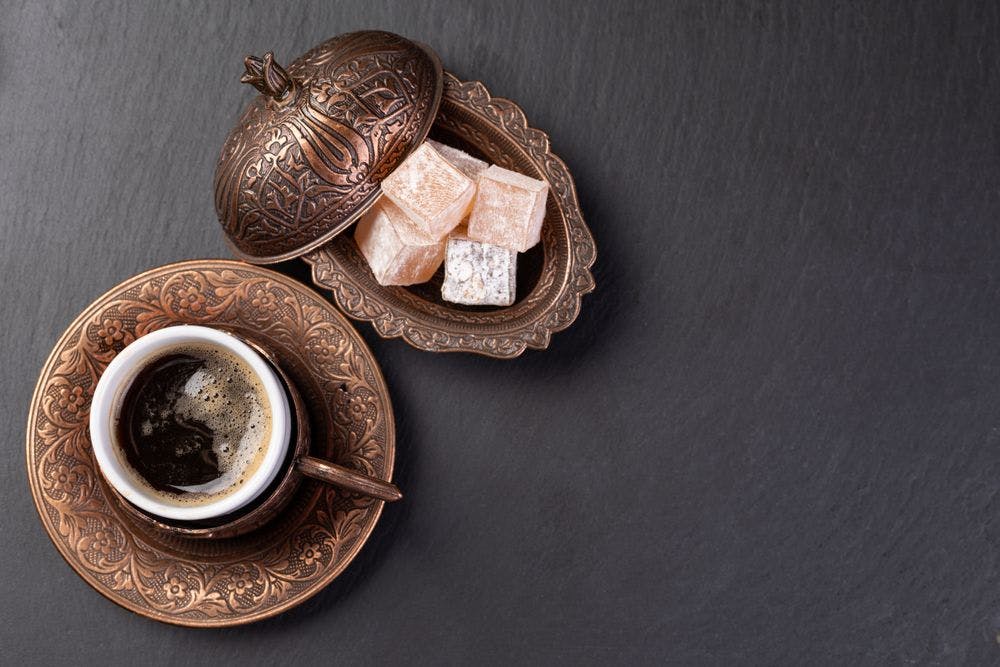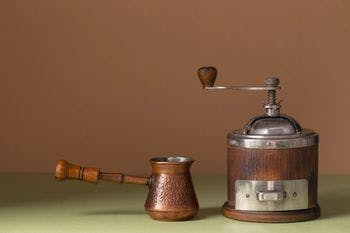
How to Make Turkish Coffee With Cezve?

Do you know there is a tradition in Turkey where the groom has to drink salty Turkish coffee as a ritual? Yes! You heard that right.
Before saying "I do," the lucky (or maybe not so lucky) groom has to sip a cup of Turkish coffee adulterated with enough salt. But why?
Even I wondered the same when I came to know it—Thinking if it is some sadistic test of endurance, a caffeine-fueled ritual, or maybe a hilarious prank by mischievous relatives.
Stay tuned with me till the end because I will be spilling the beans here. In this blog, I will also share with you what Turkish coffee is, how it is made, and its rich history.
So let's dive in.
What is a Turkish coffee?
Turkish coffee is not just coffee. It's a tradition bursting with robust flavor, a cultural experience that has stood the test of time.
Recognized for its finely ground coffee beans, unique preparation method, and aromatic charm, Turkish coffee is a flavorful and cherished part of Turkish heritage.
History of Turkish coffee
Ah, Turkish coffee – soaked in history and flavor, it's more than just a morning pick-me-up. It has the deep tales of sultans, bustling bazaars, and the slow art of savoring.
History depicts that a governor in Yemen brought this coffee tradition to the Ottoman court. Since then, Turkish coffee has become a coffee sensation, swirling through grand ceremonies and fueling late-night debates.
By the 16th century, coffeehouses known as "qahveh khaneh" began to emerge in major cities like Istanbul. These establishments quickly became social hubs, fostering intellectual discussions, musical performances, and a unique camaraderie centered around the shared love for this new found beverage.
Since then Turkish coffee has become a cultural cornerstone. Coffee houses in Turkey are considered as hubs for gossip, poetry, and even political conspiracy. Imagine smoky rooms filled with swirling steam, the clack of dice, and the murmur of philosophers debating life over tiny cups of this rich brew.
But like all trends, Turkish coffee was not the topic of discussion for long. In the 19th century, European-style coffee started brewing problems. Suddenly, instant pleasure replaced slow rituals, and tiny cups were swapped for oversized mugs.
The cultural significance of Turkish coffee was officially recognized by UNESCO in 2013 when it was added to the representative list of the intangible cultural heritage of humanity. This acknowledgment highlighted the importance of Turkish coffee in shaping social interactions and preserving cultural heritage.
Today it is served by specialty cafés offering the traditional experience. It's a reminder that sometimes, the slow things in life – like savoring a perfectly brewed cup of Turkish coffee – are the ones that truly matter.
And speaking of traditions, how can we miss the most unique Turkish tradition? Turkish weddings have a salty surprise for grooms! Before "I do," they face a cup of Turkish coffee loaded with salt – a playful test of character and love.
Back in the day, the bride brewed this salty message if she wasn't keen on the match. Today, it's a fun tradition, with the groom bravely facing the salty brew to prove his devotion. It’s a pure reflection of love and tradition.
Can you make Turkish coffee at home?
Yes! You can easily make Turkish coffee at home in simple steps. It's not just a drink but indeed an art, a ritual. It is easier than you think. No need for fancy equipment, just a little curiosity, and the right equipment is all you need.
What traditional equipment are used to make Turkish coffee?
1) Roasting pans
1. Tava
Found in grand mansions and palaces, Tava is an elegant, long-handled pan crafted from beaten iron or clay. Its flat design, coupled with a graceful handle, allows for a theatrical bean-swirling performance over an open flame.
2. Tambur
Resembling a cauldron, Tambur employs a hand-turned cylinder on a small grill. Roasting becomes a miniaturized wonder as the cylinder gently spins over the flames.
2) Cooling bins
Hand-carved wooden cooling bins showcase both artistry and functionality. After roasting, beans find a home in these meticulously crafted containers adorned with intricate carvings, reflecting Turkish woodwork expertise.
3) Mortars and mills
1. Dibek
A robust stone or wooden giant, Dibek, with its heavy grinder, crushes beans effectively. It functions as a large mortar and grinder duo, handling even the toughest beans.
2. Havan
Smaller and often in bronze, Havan offers a more intimate grinding experience. Think of it as a sturdy bronze mortar and pestle set, perfect for smaller batches or a delicate touch.
3. Hand mills
Portable and convenient, Brass or wooden hand mills bring ease to the coffee ritual. Their compact design makes them ideal for home and travel.
4. Yer mills
Larger brass or wooden mills equipped with iron mechanisms handle bigger batches effortlessly. Imagine a stationary mill, grinding away with the satisfying whir of gears.
4) Cezve
The centerpiece, Cezve, a small copper or brass pot with a long handle, cradles the coffee in a dance with water and heat. Its narrow design and thick walls concentrate flavor, creating the signature creamy foam.
5) Cup holders and coffee sets
Delicate handleless porcelain or china cups find a home in gleaming "tombak" or gilt copper cup holders, adding elegance to the coffee experience.
Beyond utensils, coffee sets, including trays, cups, saucers, and serving vessels crafted from silver, copper, or "tombak," adorned with intricate carvings and imperial seals, transform coffee into an exquisite art form.
Ingredients needed
- 5 to 6 ounces cold water
- 2 tablespoons extra finely ground coffee, such as Kurukahveci Mehmet Efendi brand Turkish coffee
- 1 to 3 teaspoons sugar, optional
Equipment needed
- Cezve
- Turkish cups
How to make Turkish coffee? (Step-by-Step)
Step 1: Make your Cezve ready
For each cup of coffee, use 1 heaping teaspoon of ground coffee. Add it to the Cezve and add some sugar and cardamom (a pinch per cup is enough to add a subtle depth of flavor) into it(around 1 teaspoon per cup).
Step 2: Pour some water
Add enough cold water into the cezve to fill your desired number of cups. Give it a gentle stir to combine the coffee, sugar, and spices.
Step 3: Place it on the heat
Put the Cezve over medium heat. Don't keep stirring continuously at this point, just let the mixture slowly warm up.
Step 4: Turn off the heat
As the mixture gets heated up, you will see a beautiful foam on the surface. Just before it becomes boiling, remove it from the heat and skim off half the foam using your spoon. Gently spoon it into your cups.
Step 5: Again put it on the heat
Return the Cezve to the heat and bring it back to just before the boiling stage. Skim off another layer of foam and spoon it into your cups, filling them almost to the brim.
Step 6: Let the coffee settle
Once done, remove the cezve from the heat and let the coffee settle for a few minutes. This will help the grounds to sink to the bottom.
Step 7: Pour the final brew
Carefully pour the coffee into your cups, leaving any remaining grounds in the cezve.
Your freshly brewed Turkish coffee is ready to be savored.
Care to take while brewing Turkish coffee
Making Turkish coffee isn't a race! Take it slow and steady: low heat helps to bring out the best flavors and builds a crown of creamy foam. Mix your coffee and sugar once, then resist the urge to stir again – let the heat do its magic.
As the coffee simmers, gently scoop off half the foam for your cups. Give it a rest, then bring it back for another spoonful of foamy goodness. Let the coffee settle, the ground sinking to the bottom, and pour into warm cups.
Savor the rich aroma and enjoy the flavorful journey, not just the destination. With a little care, you can brew 'like a pro and appreciate this ancient tradition in every sip.
Wrapping up
So, there you have it! A step-by-step journey into the world of Turkish coffee, a brew steeped in history and bursting with flavor. Remember, it's not just about the caffeine kick, it's about the ritual, the aroma, and the frothy magic in every cup.
Take your time, embrace the slow brewing, and savor the rich notes in every sip. You're not just making coffee, you're connecting to a centuries-old tradition, a culture of hospitality, and shared moments.
So go forth, brew with care, and share the magic of Turkish coffee with the world.
FAQs
1) Why is water served with Turkish coffee?
Water is served to wash the palate between sips. It allows the drinker to fully appreciate the subtle flavors of the rich and concentrated Turkish coffee.
2) Is Greek coffee the same as Turkish coffee?
While similar, there are a few differences in preparation and serving styles. Both are known for their finely ground coffee and unfiltered brewing, but they differ in tradition and presentation.
3) Can you put milk in Turkish coffee?
Traditional Turkish coffee is mostly served without milk. The focus is on the intense and concentrated flavor, and the addition of milk is not a common practice.
4) Do I need a specific type of coffee beans to brew it?
Yes, finely ground Turkish coffee is essential for its distinct flavor and texture. Opt for a coffee ground almost as fine as powdered sugar for an authentic brew.

I am a coffee aficionado based in Seattle. I have devoted my passion and expertise to perfecting the art of home coffee brewing. I became known for my exquisite pour-over and espresso creations. I source coffee beans from local roasters and explores ...



